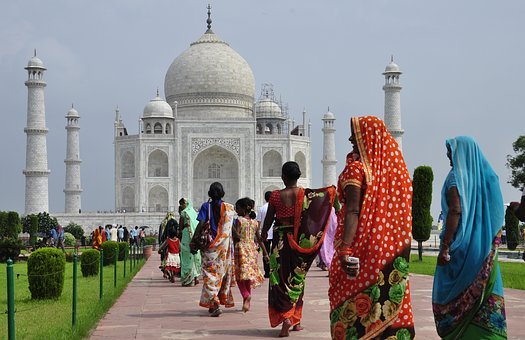The implications of the coronavirus can be felt in every nook and corner of the country as we step onto deserted roads and public places, closed schools, theatres and malls and an ambience where the fine line between precaution and panic seems to be fast disappearing. In a move to contain the spread of the coronavirus and ensure that its cases continue to be kept under control, the government has ordered the closure of all the monuments that fall under the Archeological Survey of India, including the Taj Mahal and the Red Fort for the public until the end of March. It is in this context that we are trying to under the implications of the coronavirus on the tourism industry in India and its impact on the lives of those whose livelihoods depend on it.
There are a total of 3,691 protected monuments and sites in India, this includes world heritage properties under the UNESCO and 50 sites and museums under the ASI. These monuments and museums will now be opened only after March 31. These sites include a wide variety of structures including temples, mosques, tombs, churches, cemeteries, palaces, step-wells, ancient mounds and rock-cut caves. The largest number of protected sites fall in the state of Uttar Pradesh at 745, Karnataka has 506, followed by Tamil Nadu which has the third highest number of monuments/sites which fall under the ASI. According to the government records, the revenue generated by tickets at monuments in India accounts for Rs 289 crore as of 2018-19, and an additional Rs 6 crore had been generated through the purchase of online tickets in 2018-19.
Taj Mahal: The Tomb of Love and Revenue

While the Taj Mahal is seen by many as the epitome of love and longing, even for the government it has proven to be a lofty site for the collection of revenue.
In fact, the Taj Mahal has been the greatest revenue earner out of a list of 116 centrally protected and ticketed monuments of the country.
In 2018-19, Taj Mahal generated an annual revenue of Rs 77 crore. Moreover, an additional Rs 4 crore was generated by purchase of tickets to the inner mausoleum in its premises. More than 68 lakh people made a visit to Taj Mahal in 2018-19 while over 2 lakh people paid or tickets to be able to enter the main mausoleum which hosts artistic artefacts and replicas of the Taj Mahal and select possessions of the Mughal emperor Shah Jahan and his queen Mumtaz Mahal.
In the absence of alternative modes of livelihood, it is quite challenging to ensure that the lakhs of people who had so far been dependent on the tourism industry, will suffer and bear the brunt of the economic slowdown in the aftermath of the global coronavirus pandemic.
In 2017-18, more than 64 lakh visitors came to the Taj Mahal and the monument collected a revenue of Rs 56 crore. The monuments that recorded the highest footfalls after the Taj Mahal were the Agra Fort(Rs 34 crore revenue), Delhi’s Red Fort(Rs 35 crore revenue) and the Qutub Minar(Rs 26 crore revenue)in the year 2018-19. Before this the Taj Mahal had been shut down during World War II in 1992 and in 1971 during the India-Pakistan war. The monument was also closed during the massive floods of 1978. However, this time, it is the first ever incidence in history when the monument has been closed due to a public health issue.
One of the most important reasons why the monuments and several other public places have been shut down is the fact that most countries are keeping up with the guidelines issued by the WHO , which has highlighted the significance of social distancing as the main strategy to keep the virus at bay. One of the important challenges that the closure of these heritage sites has posed before us is how to ensure that the thousands of workers who are dependent on the tourism industry for their livelihood are given alternatives methods of surviving and how they are enabled to earn their incomes in these hard times. Official estimates tell us that the closure of the monuments and heritage sites in Agra alone have hit the incomes of attest 1.5 lakh people which primarily comprises of rickshaw pullers, taxi drivers, photographers, parking attendants, shopkeepers, homestay owners, street vendors and hoteliers among others.
While we cannot deny the fact that the number of people began to gradually fall as soon as the travel ban came into effect, its strongest implications have become evident only in recent times with the complete lockdown of all tourist places.
Closure of these tourist sites has meant a lockdown on employment and livelihoods for a large section of people dependent on the tourism industry.
It is quite interesting to note for example that according to government estimates, there are around 2,000 guides in Agra and on an average they earn anything between Rs 1000-Rs 5000/- in a day, but ever since the lockdown all their employment options have been closed. They no longer have a source of income and neither can they opt for any alternative livelihoods in the meantime, because the conditions laid down by the government bar them from doing so, or else their licenses are snatched away.
In Rajasthan too, all the forts and monuments have been shut down due to the precautions associated with the spread of coronavirus.

The ASI has shut down all the 224 protected sites across the state till the end of March. Foreign and domestic tourists are now ‘banned’ from the state as all popular tourist places have been closed down.
It would not be wrong to then say that the tourism sector in India comprising of hospitality, transport, events and handicrafts businesses has been strongly impacted by the financial crisis brought about by the spread of the coronavirus. In the absence of alternative modes of livelihood, it is quite challenging to ensure that the lakhs of people who had so far been dependent on the tourism industry, will suffer and bear the brunt of the economic slowdown in the aftermath of the global coronavirus pandemic. But the question that ought to be asked is whether the government is really ensuring that effective measures are taken so that people find alternative livelihoods in the meantime and their day to day lives are impacted far less adversely than they are at present? In a truly concerned social order, we would be caring as much for public health as we would for sustaining livelihoods even in difficult moments such as these.
Ananya Pathak/Associate Editor/The New Leam.
Explore our full coverage of Cronavirus Outbreak – https://thenewleam.com/tag/cronavirus/



